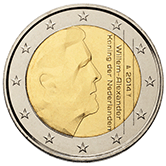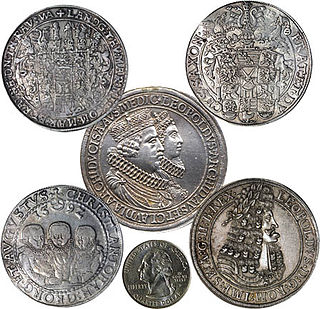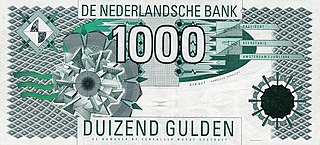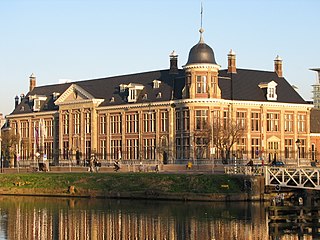
Dutch euro coins currently use two designs by Erwin Olaf, both of which feature a portrait of King Willem-Alexander of the Netherlands. The new designs began circulating in 2014. Dutch Euro coins minted from 1999 to 2013 feature a portrait of Queen Beatrix designed by Bruno Ninaber van Eyben. All coins share the 12 stars of the EU and the year of imprint in their design.

A thaler or taler is one of the large silver coins minted in the states and territories of the Holy Roman Empire and the Habsburg monarchy during the Early Modern period. A thaler size silver coin has a diameter of about 40 mm and a weight of about 25 to 30 grams. The word is shortened from Joachimsthaler, the original thaler coin minted in Joachimsthal, Bohemia, from 1520.

The House of Orange-Nassau is the current reigning house of the Netherlands. A branch of the European House of Nassau, the house has played a central role in the politics and government of the Netherlands and elsewhere in Europe, particularly since William the Silent organised the Dutch Revolt against Spanish rule, which after the Eighty Years' War (1568–1648) led to an independent Dutch state. William III of Orange led the resistance of the Netherlands and Europe to Louis XIV of France, and orchestrated the Glorious Revolution in England that established parliamentary rule. Similarly, Queen Wilhelmina of the Netherlands was instrumental in the Dutch resistance during World War II.

The ducat coin was used as a trade coin in Europe from the later Middle Ages to the 19th century. Its most familiar version, the gold ducat or sequin containing around 3.5 grams of 98.6% fine gold, originated in Venice in 1284 and gained wide international acceptance over the centuries. Similarly named silver ducatons also existed. The gold ducat circulated along with the Florentine florin and preceded both the modern British pound sterling and the United States dollar.

The guilder or florin was the currency of the Netherlands from 1434 until 2002, when it was replaced by the euro.

The Netherlands Antillean guilder is the currency of Curaçao and Sint Maarten, which until 2010 formed the Netherlands Antilles along with Bonaire, Saba, and Sint Eustatius. It is subdivided into 100 cents. The guilder was replaced on 1 January 2011 on the islands of Bonaire, Saba and Sint Eustatius by the United States dollar.

The rijksdaalder was a Dutch coin first issued by the Republic of the Seven United Netherlands in the late 16th century during the Dutch Revolt which featured an armored half bust of William the Silent. It was the Dutch counterpart of the Reichsthaler of the Holy Roman Empire but weighed slightly less, at 29.03 g of 0.885 fine silver, reduced to 0.875 fine by the 17th century. Friesland, Gelderland, Holland, Kampen, Overijssel, Utrecht, West Friesland, Zeeland, and Zwolle minted armored half bust rijksdaalders until the end of the 17th century.

The Netherlands Indies guilder was the unit of account of the Dutch East Indies from 1602 under the United East India Company, following Dutch practice first adopted in the 15th century. A variety of Dutch, Spanish and Asian coins were in official and common usage. After the collapse of the VOC at the end of the 18th century, control of the islands reverted to the Dutch government, which issued silver 'Netherlands Indies' guilder and fractional silver and copper coins until Indonesian independence in 1945.

The Dutch Five guilder coin was the highest-denomination coin in the Netherlands from its introduction in 1988 until the adoption of the euro in 2002. Its nominal value was ƒ 5,-.

The Dutch One guilder coin struck under the reign of King William II was a unit of currency in the Netherlands.
The One guilder coin was a coin struck in the Kingdom of the Netherlands between 1818 and 2001. It remained in circulation until 2002 when the guilder currency was replaced by the euro. No guilder coins were minted in the German occupation of the Netherlands in World War II.

The Dutch Maiden is a national personification of the Netherlands. She is typically depicted wearing a Roman garment and with a lion, the Leo Belgicus, by her side. In addition to the symbol of a national maiden, there were also symbolic provincial maidens and town maidens.

The Royal Dutch Mint based in Utrecht, the Netherlands, is a company owned by Heimerle + Meule. It was established and previously owned by the Dutch state.
The ducaton, ducatone or ducatoon was a crown-sized silver coin of the 16th-18th centuries.

The twenty-five cent was a coin worth a quarter of decimal Dutch guilder. It was used from the decimalisation of the currency in 1817 until the Netherlands adopted the euro as sole currency in 2002. The last minting was in 2001. The coin was the third-smallest denomination of the guilder when the currency was withdrawn, and the largest of a value less than one guilder.

The Dutch Republic Lion was the badge of the Union of Utrecht, the Republic of the Seven United Netherlands, and a precursor of the current coat of arms of the Kingdom the Netherlands.

Johann Georg Holtzhey, was an 18th-century Dutch medallist and mint master.
The Half guilder coin was a silver coin struck in the Kingdom of the Netherlands between 1818 and 1930. The obverse featured a portrait of the Dutch reigning King or Queen. On the reverse was a crowned Dutch coat of arms between the value. All coins were minted in Utrecht except the year 1829 and 1830 that were minted in Brussels.
The Three guilder coin was a silver coin struck in the Kingdom of the Netherlands between 1817 and 1832.
















